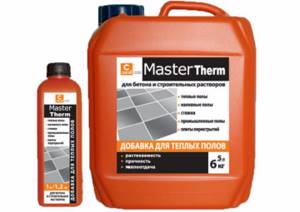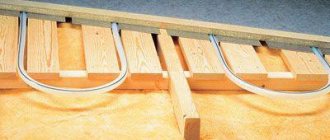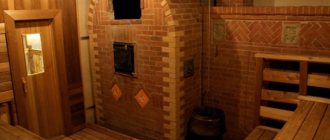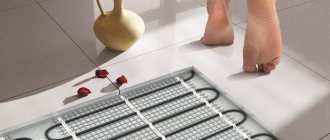When installing an internal heating system, the most important point is a high-quality screed, which in the future will become the basis for the finishing coating. The reliability and durability of the heating system will depend on its solidity and level of strength. For this reason, it is important what material will be used. If until recently a sand-cement mixture was used for this, now, thanks to the latest technologies, special components and additives have been developed.
So, the most effective component is a plasticizer for screeding a warm water floor, which makes it possible to create a holistic and strong base.
Short description
The higher quality and better the cement layer, the more effective the heating of the rooms will be. When pouring a heated floor, you will need good quality concrete, and this is difficult to achieve without using a plasticizer for the screed. The sand-cement mixture used does not have all the necessary technical and operational characteristics to ensure truly effective operation of underfloor heating. The design of underfloor heating itself is characterized by temperature changes in the cement layer, which sooner or later will provoke a violation of integrity and the appearance of microcracks. In addition to the destruction of the concrete itself, the finishing flooring (decorative stone, tiles, etc.) is also deformed, and sometimes even disturbances in the performance of the heat source appear, not to mention the fact that it is very difficult to obtain complete solidity of the poured layer from a standard mortar.
If, when laying the mixture, air pockets are formed, this entails a decrease in the functionality of the floor heating system as a whole. Floor plasticizer can be bought at any hardware store, and this is the right choice, as it will make the concrete mixture better and more homogeneous, and this will have a beneficial effect on the pour.
The mixture becomes plastic, and due to its universal composition it receives additional pleasant properties:
- Increased performance characteristics.
- Waterproofing.
- High adhesion rates (this is the ability to bond with different materials).
Kinds
Today, various types of plasticizers are produced:
- Dry. This type is used most often, because it is characterized by a long storage period. Before adding it to concrete, you must first mix the solution with water.
- Liquid. This type has an advantage over the dry one in that it does not need to be diluted with water; during the preparation of the solution, you just need to add the required amount to the concrete.
- Reinforcing. Contains substances that make the screed more durable.
- Anti-frost. The dry or liquid composition is enriched with special frost-resistant components that prevent the plasticizer from crystallizing even at sub-zero temperatures.
When choosing one or another type of plasticizer, it is worth taking into account the technical characteristics of your home, because each of the above options is characterized by individual properties that will be suitable for certain conditions of use. Therefore, in order to choose the most optimal option, consult with specialists.
Choosing a pipe for a warm floor.
Material composition
Plasticizers that are used for floor screed have different components in their composition, and some manufacturers even try to hide some of the components to create a unique product.
But at the same time, there is a list of main components that are almost always used:
Waste material purified from phenol.- Concentrated sulfuric acid.
- Composite (formalin).
- Purified water.
- Substances that contribute to the extinction of foam.
- Caustic soda in liquid form.
Due to this composition, it is possible to achieve the required homogeneity of concrete, as well as to avoid the formation of air pockets inside the floor during pouring. The screed for a warm electric floor does not allow any cracks, air voids or gaps at all. Such costs of concrete screed can lead to the fact that in empty areas the cable begins to overheat and the system may suffer due to a short circuit. If you plan to lay an electric cable floor, then you MUST use a plasticizer!
Advantages and disadvantages
Like any other consumable material, plasticizer for underfloor heating screed, the price of which will largely depend on the quality of the product and the manufacturing company, has its advantages and disadvantages.
Advantages:
- The floor surface becomes denser and becomes waterproof, and this is important when installing and using heated floors in the future.
- Thanks to this additive, it is possible to achieve high mechanical strength of concrete pouring. Even after several decades, the concrete base will still be the same monolithic and high-strength.
- Saving consumables. Thanks to the use of a suspension, it is possible to reduce the laying of the cement base by 15%, while this does not in any way affect the characteristics, especially strength.
- The composite is pliable and movable, which, when filling the screed, will help ensure solidity without any air pockets or voids.
- Some types of plasticizers (which are more expensive than regular ones) help protect the metal reinforcement grid from corrosion. Thus, both the fittings and the metal elements of the floor heating system will not be damaged.
- The main advantage is the high service life of the prepared mixture - you have the opportunity to prepare a sufficient amount of the mixture in advance and not be afraid of hardening before you finish pouring.
- The plasticizer helps neutralize the effects of a 5%-1 mixture of potassium nitrate, due to which salt will not appear on the concrete.
I would like to add that plasticizers do not have a strong odor and retain their properties for a long time. They also do not emit any toxic substances, i.e. the product is completely ecological.
Flaws:
The only disadvantage of this composition is that it hardens for a very long time. But this can still be corrected by adding special hardening accelerators. Taking into account this drawback, we do not recommend using such a component in cases where you do not have the opportunity to wait until everything hardens naturally so that the surface is ready for the rest of the work, namely laying the finishing layer.
The problem of long hardening is easily solved - use a hardening catalyst. Such additives as a modification, although they will increase the final cost of the screed, will allow it to quickly harden, and with this approach the hardening time period will be even shorter than that of a cement-concrete mixture.
Procedure and method of application
First, let's talk about the proportions in which the additive should be used. It is produced in the form of a liquid solution, but sometimes it is a powder, i.e. dry composition. Liquid composites should be mixed with the remaining components, and then mixed thoroughly and added together with water when mixing. The solution should be added from 1 to 1.5 liters per 100 kg of dry cement mixture. When using dry material, you should take one measure of powder to two measures of water, then mix thoroughly and leave for 2-3 hours. When the specified time has elapsed, the resulting suspension can be administered according to a similar principle as described above. Using a plasticizer to screed a heated floor is carried out in several stages, so let's look at each one.
Stage No. 1
The additive is introduced into the sand-concrete mixture or other solution that will be used to fill the coating, and this is done simultaneously with the introduction of the remaining components. After this, mix all components thoroughly for about 1.5 hours. For this, it will be more convenient to use a concrete mixer, but if such a device is not available, then you will have to mix all the components using the standard method - a drill with a special attachment.
Stage No. 2

Now you have a ready-made composition. You can use it to fill surfaces for any purpose - in industrial openings, for hidden heating systems and more. A fairly important point is that when using it, you need to distribute the mixture evenly over the entire surface. The final quality and reliability of the base will depend on this.
Stage No. 3
The next step is to create a cement grout layer to ensure complete hardening. If the room does not have a high level of humidity, but after a week the surface will be ready for the rest of the work, namely laying the decorative layer of coating. After 14 days, you will be able to place furniture in this room and not worry that the screed may become deformed.
How to make it yourself
If you want to save money and get an environmentally friendly product, you can prepare a plasticizer for underfloor heating screed yourself. The process is not complicated and does not take long.
To add viscosity to the solution you need to take:
- shampoo or liquid soap;
- washing powder, which should be dissolved in water.
The procedure for producing the mixture is as follows:
- Sand, cement and water are taken and mixed until a homogeneous composition is obtained.
- Mix liquid soap or washing powder into 200 ml of liquid. This combination will slow down hardening by 3 times and reduce the formation of cracks by 4 times.
- The mixture is added at the moment when the cement mortar is in the mixer and mixed again.
- To reduce the risk of cracks, you can add slaked lime along with the soap solution; it will slow down the hardening process. Take 30 grams of lime per 50 kg of solution.
However, experts warn that soap contains various additives, and this can negatively affect concrete over time, so they advise it is better to buy plasticizers for warm structures from well-known manufacturers.
Today, the main requirement for concrete structures is increased quality and reliability; a plasticizer was invented for this purpose; it will increase the viscosity of the solution; it is not recommended to make a screed without it.
Varieties
Let's take a closer look at what types of plasticizers there are for water floor screed:
- Liquid.
- Dry.
- Antifreeze additive.
- Reinforcing polyamide fiber.
Each of these types of substance helps speed up the hardening process and makes the solution more plastic. The antifreeze additive makes it possible to work with concrete even at subzero temperatures. The choice of plasticizer should be based on the floor heating system, as well as the installation method. This is important for a water floor, since the screed must tightly fit the pipes. This is possible only with an elastic solution. The plasticizer will help ensure that the screed is free of air gaps and homogeneous - this will help make it durable. Such a screed can withstand heavy loads, and this is important for underfloor heating pipes, because if the floor is damaged there is a danger of damage to the pipes. For this reason, the screed must be at least 2.5 cm.
When creating an electric floor heating system, a dry mixture is used under the tiles, and adhesives are added for better elasticity and strength. The price of the plasticizer will be the same or even slightly less than that of high-quality cement. The cost will also be affected by consumption and characteristics. As a rule, from 600 to 1000 ml of plasticizer are used per 1 m2 of mixture. If you buy a cheap composition, the consumption will be higher, so you are unlikely to save money. It is better to purchase high-quality materials, as this is a guarantee of reliability, and the service life will be much longer.
On the construction market there are a huge number of brands of plasticizers for sand-cement and other similar mortars. They can be bought on the market, in specialty stores, and online.
How to choose what to pay attention to
When choosing the best plasticizer for a floor, you should take into account both the quality and model of the additive, as well as the conditions in which it will be used, because each type has its own characteristics.
Today, a number of additives are produced that are designed for heated floors. Before purchasing the material, you need to familiarize yourself with the characteristics that are on the packaging. In addition, there manufacturers indicate compatibility with warm systems.
Key points to pay attention to when purchasing a floor filler:
- the substance must be compatible with the brand of cement in order to obtain a plastic mixture;
- have no odor;
- do not release under the influence of liquids and oils.
What plasticizer to choose for installing a water floor, you need to take into account the presence of air bubbles inside the resulting composition, so a dry product is better suited.
And when installing an electrical system, use semi-dry pouring, the mixture consists of sand, cement powder, plasticizer, fiber fiber and a little water, this will prevent the formation of cracks on the surface. That is, it is recommended in liquid form, with increased plasticity.
The best plasticizers
There is a wide variety of ready-made mixtures on the modern construction market, but we will only tell you about the best.
The interesting thing is that these are the best formulations, especially in terms of price-quality ratio:
- Sa npro l. This is a liquid composition that helps achieve high strength and ductility even when frozen. The addition helps reduce the amount of water for mixing to approximately 20% and the plasticizer should be added at a rate of 100 ml per 200 kg of cement. A special advantage of Sanpol is that even with the initial setting of the screed, you can even correct small flaws.
- The same properties that the plasticizer for underfloor heating Sanpol has apply to all products from, and there is only one difference - you need to use a liter of plasticizer for every 100 kg of cement. It can be poured at any temperature, from -27 to +55 degrees. The material is of high quality and can only be used in conjunction with high-quality concrete. The composition significantly increases the strength of the finished surface and helps eliminate any air pockets during hardening.
- RENA U. This is a product that belongs to the premium segment, which has excellent characteristics. For a thin screed this will be an ideal option; there are simply no competitors to such a composition. Add 100 ml to the solution for every 100 kg of cement.
In the end, I would like to note that the use of such compositions greatly simplifies the installation of an internal heating system, and this helps to make it as safe and reliable as possible, which is already important.











